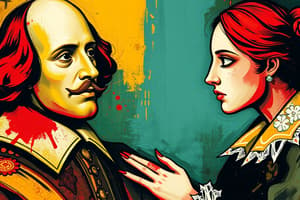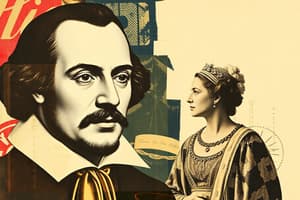Podcast
Questions and Answers
What is the significance of the gold casket in 'The Merchant of Venice'?
What is the significance of the gold casket in 'The Merchant of Venice'?
- It symbolizes greed and desire for wealth. (correct)
- It represents true love that is not materialistic.
- It signifies wisdom and intelligence.
- It mirrors the importance of mercy over justice.
In 'The Merchant of Venice', what message is found inside the silver casket?
In 'The Merchant of Venice', what message is found inside the silver casket?
- 'Who chooseth me shall get as much as he deserves, and not a jot more.'
- 'Who chooseth me shall get as much as he deserves.'
- 'Who chooseth me shall receive the gift of wisdom.' (correct)
- 'Who chooseth me shall gain what many men desire.'
Which character borrows money from Antonio to woo Portia in 'The Merchant of Venice'?
Which character borrows money from Antonio to woo Portia in 'The Merchant of Venice'?
- Shylock (correct)
- Antonio
- Bassanio
- Portia
What literary device is used when words are used in place of actions in 'The Merchant of Venice'?
What literary device is used when words are used in place of actions in 'The Merchant of Venice'?
Which theme is reflected in the lead casket scene in 'The Merchant of Venice'?
Which theme is reflected in the lead casket scene in 'The Merchant of Venice'?
What role does Portia play in the casket scene of 'The Merchant of Venice'?
What role does Portia play in the casket scene of 'The Merchant of Venice'?
What literary device is commonly used by Shakespeare in 'The Merchant of Venice'?
What literary device is commonly used by Shakespeare in 'The Merchant of Venice'?
How does Portia intervene to prevent Shylock from taking Antonio's life?
How does Portia intervene to prevent Shylock from taking Antonio's life?
What theme is prominently explored through Shylock's pursuit of revenge in the play?
What theme is prominently explored through Shylock's pursuit of revenge in the play?
Which character challenges gender norms in 16th-century Venice?
Which character challenges gender norms in 16th-century Venice?
What symbolizes the dangers of wealth and the corrupting influence of money in the play?
What symbolizes the dangers of wealth and the corrupting influence of money in the play?
What motivates Shylock's pursuit of revenge against Antonio?
What motivates Shylock's pursuit of revenge against Antonio?
Flashcards are hidden until you start studying
Study Notes
Merchant of Venice: A Tale of Symbolism, Plot, Literary Devices, Themes, and Characters
Set in the bustling city of 16th-century Venice, "The Merchant of Venice" by William Shakespeare is a play that weaves together elements of tragedy, comedy, and courtroom drama. This exploration will delve into the rich symbolism, the plot's intricate twists, the literary devices employed, the core themes, and the complex characters within this enduring Shakespearean classic.
Symbolism
Throughout the play, Shakespeare employs several symbols that underscore its central themes. The most prominent of these is the casket scene when Portia disguises herself as a doctor and offers Bassanio three caskets, one gold, one silver, and one lead. The gold casket contains a message that says, "Who chooseth me shall gain what many men desire." The silver casket offers, "Who chooseth me shall get as much as he deserves." The lead casket promises, "Who chooseth me shall get as much as he deserves, and not a jot more." The lead casket contains Portia's portrait, reflecting the idea that true love is not materialistic or self-seeking.
The role of money and the law is symbolized through the bond contracted by Antonio to Shylock and the manner in which the play's characters often use words in place of actions.
Plot Summary
The plot centers around Bassanio, a nobleman who borrows money from his friend Antonio to woo Portia, a wealthy heiress. To obtain the loan, Antonio pledges a pound of his own flesh as security to Shylock, a Jewish moneylender. As circumstances spiral, Portia disguises herself as a lawyer and outsmarts Shylock in a courtroom, ultimately preventing him from taking Antonio's life. In the end, Bassanio and Portia are married, and Antonio's friends pay Shylock to free him from the bond.
Literary Devices
"The Merchant of Venice" is rich in literary devices that enhance its depth and complexity. The play is written in iambic pentameter, a versification pattern commonly used by Shakespeare. The play also relies on the use of soliloquies, monologues, and asides to reveal character emotions and thoughts. Shakespeare uses symbolic language, metaphors, and personification to emphasize his themes and to create vivid imagery.
Themes
The play explores several themes, the most notable of which are:
- Love and marriage: Portia and Bassanio's relationship reveals that love and marriage require mutual respect and understanding.
- Revenge and justice: The play explores revenge, justice, and forgiveness, as seen in Shylock's pursuit of revenge against Antonio and the play's conclusion, which ultimately shows mercy.
- Religion and ethnicity: The play addresses the tensions between Christians and Jews in 16th-century Venice, with Shylock serving as a prominent example of religious and ethnic prejudice.
- The role of money: The play critiques the dangers of wealth and the corrupting influence of money, as represented by the character of Shylock.
Character Analysis
"The Merchant of Venice" features several complex characters, each with their own unique motivations and flaws.
- Shylock: Shylock is a complex character whose motives are often misunderstood. He is a victim of religious and ethnic prejudice, and his pursuit of revenge against Antonio reflects his desire for justice and respect.
- Portia: Portia is a strong, intelligent, and independent woman who challenges gender norms in 16th-century Venice. She is a symbol of love and justice and is a prominent example of female agency and empowerment in Shakespearean literature.
- Antonio: Antonio is a noble and selfless man who places the needs of his friends before his own. Despite his kindness, Antonio is often overshadowed by his financial insecurity and his relationship with Shylock.
- Bassanio: Bassanio is a charming and ambitious man who seeks to win Portia's hand in marriage. His pursuit of wealth and love ultimately leads to a greater understanding of the true nature of love and marriage.
In conclusion, "The Merchant of Venice" is a complex and multifaceted play that explores themes of love, revenge, justice, religion, and the corrupting influence of money. The play's rich symbolism, engaging plot, and complex characters make it a timeless classic that continues to captivate audiences today.
Studying That Suits You
Use AI to generate personalized quizzes and flashcards to suit your learning preferences.




